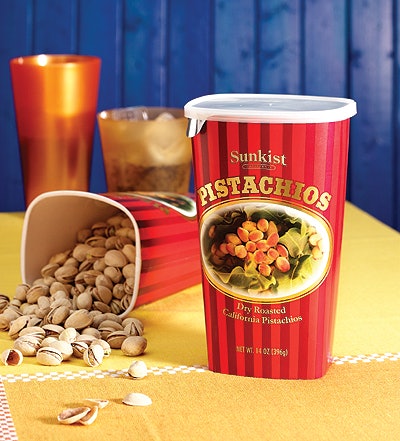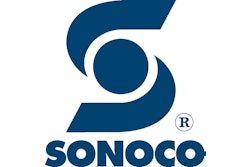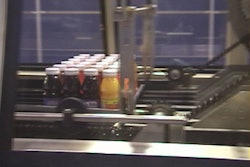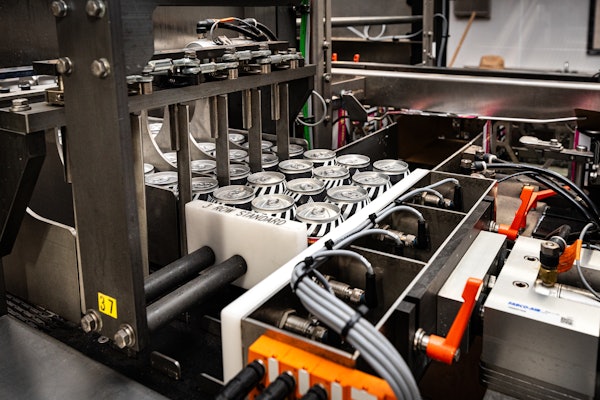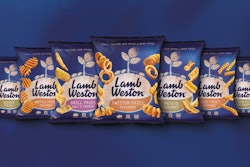When Paramount Farms launched its holiday promotion package of Sunkist-brand pistachios this month, the Los Angeles firm became the first to use Sonoco’s SonoWrap™ “single-wrap” fiber can technology. The 14-oz pack of in-the-shell pistachios is being rolled out nationwide just ahead of and during the Christmas holiday season. It sells for $4.99 and is being merchandised in the same part of the supermarket where Paramount Farms’ other pistachio packs can be found: the produce section.
“While we do a fall promotion and a Super Bowl promotion, we had never done anything specifically for the holidays,” says Paul Hachigian, Paramount Farms’ vice president of marketing. “When we made the decision to do a holiday promotion, we also decided to go to an entirely new packaging format. But first we had to find it.”
Standing 172 mm tall, 97 mm deep, and 110 mm wide (6.77” x 3.82” x 4.33”), the container has a 4½º taper from top to bottom. Sonoco refers to it as a “single-wrap” container because, unlike conventional fiber cans made by Sonoco and others, the SonoWrap is made from a single ply. To understand why this is significant, it helps to review how fiber cans are typically made.
Also referred to as “composite” cans, conventional fiber cans are made by winding roll-fed overlapping layers of material around a mandrel to form an open-ended continuous tube. The tube is cut into individual can bodies and the bottoms of the bodies have metal, plastic, or composite paperboard ends seamed or glued to them. After the can is filled, a similar end is seamed or glued to the top. The chief appeal of such a container? Typically it costs less than its metal, glass, or plastic counterparts.
The SonoWrap, like conventional composite cans, is also formed around a mandrel. But there is a key difference. Rather than wrapping multiple plies of roll-fed material around a mandrel to form a continuous tube, a single blank is wrapped around the mandrel and there is no continuous tube. If gas and/or moisture barrier properties are not an issue, that single ply can be as simple as the one used to make the Paramount Farms container: 15-pt cup-stock paper coated on both sides with low-density polyethylene.
The making of the Paramount Farms container begins with sheet-fed printing. Then comes foil stamping, followed by die-cutting/embossing. Can making is next. On a system supplied by Horauf, flat blanks are wrapped around a mandrel and a heat sealed seam turns flat blanks into canister bodies. In a subsequent station, roll-fed bottom stock—the same as the body stock—is die cut, formed, and heat-sealed to the body. All that remains is rolling the bead at the top and automatic discharge into nested stacks.
If barrier properties are required in a SonoWrap container, a foil layer can be added to the paper stock in an extrusion lamination. Such a structure would likely be LDPE coating/cup stock/extrusion-laminated LDPE/foil/LDPE coating. Its bottom would have the same foil-based structure and heat-sealed to its flange at the top would be a foil membrane, making it a high-barrier container all around.
Despite its multilayer construction, such a container would still be called a “single-wrap” container because its manufacturing process would involve the wrapping of only one ply. Sonoco’s Kevin Sands calls it “the only hermetically sealed single-wrap container available in the U.S. marketplace.”
Because SonoWrap containers are made as discrete units as opposed to being cut from a continuous tube, they can be tapered. That means they can be nested, which brings a huge space savings in distribution and warehousing prior to filling.
Other benefits compared to conventional fiber cans include special graphic effects, such as embossing, for example, that can’t be done on conventional composite cans.
Embossing front and back
Paramount Farms is taking full advantage of its new pack’s embossability. On the front panel, “on-the-tree” pistachios are embossed in a vignetted oval, bringing the delectable nuts to three-dimensional life so consumers can see, feel, and almost taste the nuts inside. The back panel also features a small group of embossed pistachios, this time in the shell.
Another graphics highlight is six-color offset printing that adds richness and depth to the red-striped holiday motif. Because the container is gently rounded rather than sharply cornered, graphics flow uninterrupted around the package. Also, gold foil stamping is used to connote the indulgent nature of the product that holiday snackers and last-minute gift seekers seek.
“We really pulled out all the stops on shelf appeal,” says Hachigian. “We wanted to make sure no one missed Sunkist pistachios during the holiday.”
Finding a package that would jump off the shelf was a task that fell to Paramount Farms marketing manager Colleen Cleveland. She knew the special holiday promotion required a move away from the firm’s standard form/fill/seal pillow pack used year-round. She searched instead for a shaped rigid package that would reposition pistachios as an elegant gift item and high-end snack for the holidays. Her search led her to Sonoco.
“I had seen Sonoco’s shaped composite can in a trade journal and was very interested,” says Cleveland. “As a rigid package, it had the enhanced shelf presence and billboarding we wanted for an impulse-oriented product.” The “shaped composite can” Cleveland refers to is Sonoco’s Linearpak® nonround composite container. “But when I spoke to a salesman about [the Linearpak], he suggested an entirely new shaped package, the SonoWrap, that was so new they didn’t even have sales literature yet. As we began to see all we could do with it, we knew it was exactly what we wanted.”
Filling and sealing
Filling the rigid container was something of a novelty for Paramount Farms. After all, most of the firm’s pistachio nuts are in pillow packs made on vertical form/fill/seal equipment.
For now, filling is a semi-automatic operation. Sonoco provided a boost in the sealing department by providing a Model HSC-50 heat-sealing system from Packaging Technologies. The machine was moved from a Sonoco facility and leased to Paramount Farms. An intermittent-motion rotary style system, it feeds foil-based lidding material from rollstock. Just after the unwind stand, a die-cut station cuts the material from the roll but leaves a few points intact so that the material does not fall out. The material then advances into the heat seal station. When the lid is positioned over a container, the heat-seal tool comes down and heat-seals the lid to the flange of the container, separating it fully from the web.
The use of an easy-peel adhesive and the inclusion of a pull tab simplify the removal of the lidding. The lidding material, supplied by Sonoco’s Flexible Packaging Div., is a four-layer adhesive lamination of 48-ga polyester/.00035” foil/48-ga polyester/3.75-mil LDPE coex. Also supplied by a Sonoco division, the Molded Plastics Div., is the injection-molded polypropylene overcaps. These are applied by hand.
As the first-of-its-kind package makes its way into the marketplace, it will be difficult to miss. Paramount Farms has created attention-grabbing point-of-purchase displays containing either 80 or 160 cups. The displays feature larger-than-life four-color images of the new package along with a clever addition: free “to/from” gift cards on tear-off pads.
Cleveland readily acknowledges that the fiber can costs more than the pillow pack in which her firm usually goes to market. How much more she doesn’t say.
“We aren’t selling this as a commodity package,” she adds. “It’s sold as a value-added premium pack. The cost gets passed through.”
Supermarket buyers, apparently, are impressed by the package.
“We made presentations to all of the major chains and walked away with orders,” says Hachigian. —PR
